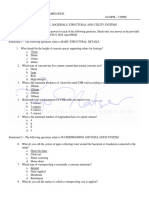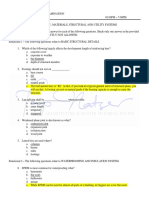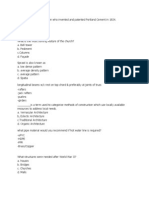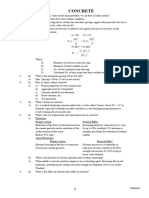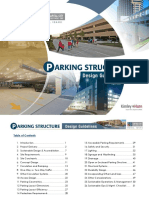Exit Exam New
Exit Exam New
Uploaded by
abdirhamenshibrushunkaCopyright:
Available Formats
Exit Exam New
Exit Exam New
Uploaded by
abdirhamenshibrushunkaOriginal Title
Copyright
Available Formats
Share this document
Did you find this document useful?
Is this content inappropriate?
Copyright:
Available Formats
Exit Exam New
Exit Exam New
Uploaded by
abdirhamenshibrushunkaCopyright:
Available Formats
Engineering Solution By Abel
1. As much as possible a bridge crossing should be ------------------- to reach of the river
a. Straight
b. Curved
c. Skewed and curved
d. Skew
A straight bridge crossing helps to minimize the length of the bridge and provide a more direct
and stable path across the river. Straight bridges are generally more cost-effective and easier to
construct compared to curved or skewed bridges. Additionally, a straight bridge can offer better
visibility and safety for drivers or pedestrians crossing the river.
2. Which painting type NOT used in buildings
a. Aluminum paint
b. Chalk paint
c. Anti-corrosion paint
d. Quartz paint
Ans. The painting type that is NOT used in buildings is quartz paint (option d).
The reasons are:
Aluminum paint (option a) is commonly used for exterior metals like aluminum panels,
downpipes etc.
Chalk paint (option b) is increasingly used as a decorative finish for interior walls, trim
work, furniture etc.
Anti-corrosion paint (option c) is used on metals that are exposed to exterior/interior
corrosion like structural steel.
Quartz paint (option d) is a special coating used for concrete floors to provide a hardened
scratch resistant surface. It is not generally used on building surfaces/structures.
Prepared By Abel Muluken Exit Exam Model 2016
Engineering Solution By Abel
3. For windward walls of rectangular (h>b) buildings, the wind pressure acting on the wall
face is
a. Uniform throughout
b. Variable throughout
c. Higher at the top and lower at the bottom
d. Lower at the top and higher at the bottom
For windward walls of rectangular (h > b) buildings, the wind pressure acting on the wall
face is c. Higher at the top and lower at the bottom. This is because wind pressure increases
with height due to the increased wind speed at higher elevations. Page 35
4. What is the reason that very often shear reinforcements are not provided in footings?
a. Because the concrete cover we use in footings is larger than we use in super-structural
elements.
b. Because footings are buried in soils and shear reinforcements can decay.
c. Because the concrete we use in footings is very special.
d. Because the thickness provided in footings is enough to withstand the shear stress.
5. Which one of the following is true about Limited Tendering
a. All eligible bidders are allowed
b. Only those passing certain qualification criteria are allowed
c. Results in lower cost
d. Consumes time for tendering and bid -evaluation
6. Height of bridge is kept above maximum flood level
a. 1.8 to 2.1m
b. 2.2 to 2.5m
c.1.2 to 1.5m
d. More than 2.5m
Prepared By Abel Muluken Exit Exam Model 2016
Engineering Solution By Abel
Ans. 1.2 to 1.5 meters
Detailed Solution. The height of the bridge is generally 1.2 to 1.5 meters above the high flood
level of the given region. Different dimensions of the bridge: Width of bridges: It is based on the
traffic survey
7. Which point on the interaction diagram corresponds to pure bending failure
A. Point A
B. Point C
C. Point E
D. Point D
8. Which item should NOT be included in the material break down for C-25 concrete
a. Reinforcement
b. Coarse aggregate
c. Cement
d. Water
Prepared By Abel Muluken Exit Exam Model 2016
Engineering Solution By Abel
9. A floor system typically consists of, except
a. Tiles
b. Glass window
c. The structural floor
d. Ceiling fixtures
10. Which one of the following describes a fully plastic section
The Answer is A
Prepared By Abel Muluken Exit Exam Model 2016
Engineering Solution By Abel
11. What makes the design and analysis of cofferdam complex than other foundation
systems?
a. The dewatering process.
b. The water pressure.
c. The size of cofferdam.
d. The distribution of the lateral earth pressure.
The correct answer is b) The water pressure.
The reasons are:
Cofferdams are built within water to allow construction in dry condition.
They have to withstand huge water pressure from all sides when dewatered inside. This
lateral water pressure is the key factor that makes cofferdam design complex.
Dewatering (option a) is just a process, not what impacts design complexity.
Size (option c) alone does not affect complexity, large foundations of other types are
designed as well.
Lateral earth pressure distribution (option d) is considered for retaining walls too, but
water pressure inside a cofferdam is unique.
12. The basic defects in mortar plastering works include, except
a. Falling out of plaster
b. Cracking
c. Strong bond with the substrate wall
d. Efflorescence
Efflorescence - Leaching out of salts to plaster surface giving a white powder
appearance.
Prepared By Abel Muluken Exit Exam Model 2016
Engineering Solution By Abel
13. Which one of the following does NOT describe column failure mode?
a. Cracking
b. Anchorage
c. Shear
d. Flexural
14. One of the following is NOT application of the design of signing and markings.
a. To limit the amount of traffic flow.
b. To inform legal speed limit.
c. To inform drivers of priority.
d. To delineate different zones of the road.
15. Which one of the following is true with regard to the partial safety factor used for
concrete and reinforcing steel
a. The partial safety factor used for concrete is larger than that of the reinforcing steel
b. The partial safety factor used for concrete is 2.0
c. The partial safety factor used for reinforcing steel is 2.0
d. The partial safety factor used for concrete and steel is 1.0
Prepared By Abel Muluken Exit Exam Model 2016
You might also like
- Ale Part 2 Answer KeyDocument27 pagesAle Part 2 Answer KeyTimothy Ryan Wang100% (2)
- PART 1 Project EngineerDocument9 pagesPART 1 Project EngineerAsh Ash100% (3)
- Reinforced Concrete Buildings: Behavior and DesignFrom EverandReinforced Concrete Buildings: Behavior and DesignRating: 5 out of 5 stars5/5 (1)
- Exit EXAM 5Document6 pagesExit EXAM 5rebukasu123No ratings yet
- Exit EXAM 6Document11 pagesExit EXAM 6Yosef GirmaNo ratings yet
- Exit Exam Questions - CoTM - April 2024Document11 pagesExit Exam Questions - CoTM - April 2024Wondemeneh Asrat100% (1)
- Exit EXAM Part 3Document9 pagesExit EXAM Part 3Henok YalewNo ratings yet
- 2.0 BOOK#05 George Book Theory MMUP Exam CollectionDocument33 pages2.0 BOOK#05 George Book Theory MMUP Exam CollectionkhaledNo ratings yet
- BMC IV - Unit 2 & 4 - Ar - Archana & Ar - ShrijaDocument15 pagesBMC IV - Unit 2 & 4 - Ar - Archana & Ar - ShrijaIswaryaNo ratings yet
- MOE Model ExamDocument20 pagesMOE Model ExamABAMELANo ratings yet
- Exit EXAM 4Document3 pagesExit EXAM 4Henok YalewNo ratings yet
- MOCK ALE Set 3A - Day 1 Part 2 Answer KeyDocument31 pagesMOCK ALE Set 3A - Day 1 Part 2 Answer KeyROQUENo ratings yet
- SfsDocument31 pagesSfsjaneNo ratings yet
- Sample Exit EXAM Perpared by Abel MDocument6 pagesSample Exit EXAM Perpared by Abel MTadesse Megersa100% (1)
- C. Design Speed: Sample 100 Items ExamDocument15 pagesC. Design Speed: Sample 100 Items ExamVirgilio Velasco IIINo ratings yet
- Group 2 Report MCQDocument8 pagesGroup 2 Report MCQCristian SereñoNo ratings yet
- Upda FinalDocument130 pagesUpda FinalmahmoudNo ratings yet
- StructuralDocument59 pagesStructuraljoseph iñigoNo ratings yet
- SET 2B Day 1 Part 2 ANSWER KEYDocument44 pagesSET 2B Day 1 Part 2 ANSWER KEYLeah Mae LabticNo ratings yet
- Mo Upda FinalDocument130 pagesMo Upda FinalomermustaafaaNo ratings yet
- SfsDocument28 pagesSfsjaneNo ratings yet
- Dubai Mnicipality G+12 - 13Document4 pagesDubai Mnicipality G+12 - 13khanakhtarmuneerNo ratings yet
- CET308 - Module 5Document26 pagesCET308 - Module 5Sajil KrishnaNo ratings yet
- StructuralDocument59 pagesStructuralJeannaNo ratings yet
- Model Exit Exam (May 2023) - Civil Engineering DepartmentDocument28 pagesModel Exit Exam (May 2023) - Civil Engineering DepartmentTadesse MegersaNo ratings yet
- Structural Answer KeyDocument59 pagesStructural Answer Keychickenwings.apvNo ratings yet
- Building Construction (Section 4) : A. B. C. DDocument12 pagesBuilding Construction (Section 4) : A. B. C. DAl RomanoNo ratings yet
- Civil Engineering Model Exit Exam Second Round-1Document17 pagesCivil Engineering Model Exit Exam Second Round-1Fira'ol Mulugeta Fira'ol MulugetaNo ratings yet
- Splbe-Flea 2013 Joint Pre-Board Examination (SET - A) : Coaxial CableDocument13 pagesSplbe-Flea 2013 Joint Pre-Board Examination (SET - A) : Coaxial CableKRISSELLE TAYCONo ratings yet
- Concrete Technology MCQ Civil EngineeringDocument11 pagesConcrete Technology MCQ Civil EngineeringAjay PawarNo ratings yet
- Debremarkos University Model Exit Exam 2015Document27 pagesDebremarkos University Model Exit Exam 2015Yosef GirmaNo ratings yet
- Construction Materials Sample Exit Exam QuestionsDocument120 pagesConstruction Materials Sample Exit Exam QuestionsSemereNo ratings yet
- Civil MCQ Questions With AnswersDocument14 pagesCivil MCQ Questions With Answersathira.surmountNo ratings yet
- COTM RND 2 Exit Model Exam 2Document16 pagesCOTM RND 2 Exit Model Exam 2Wondemeneh AsratNo ratings yet
- T.A. Marryshow Community College School of Applied Arts & Technology DEPARTMENT OF: Building Technology Resit ExaminationDocument9 pagesT.A. Marryshow Community College School of Applied Arts & Technology DEPARTMENT OF: Building Technology Resit ExaminationkevinblacheNo ratings yet
- Model Exam CotmDocument16 pagesModel Exam CotmWondemeneh AsratNo ratings yet
- CAE 506 Homework Set 1 - 2024Document3 pagesCAE 506 Homework Set 1 - 2024Jyothirmayi JosephNo ratings yet
- ESE 2016 SolutionDocument57 pagesESE 2016 SolutionVivekChaudhary75% (4)
- Week 3 SolutionDocument6 pagesWeek 3 SolutioncsefmcetNo ratings yet
- Random QuestionsDocument20 pagesRandom QuestionsElline Ivy CalitisNo ratings yet
- Civil-Environmental Engineering TriviaDocument26 pagesCivil-Environmental Engineering TriviaK.Rajesh WaranNo ratings yet
- Civil Engineering Model Exit Exam - 2016 2nd RoundDocument18 pagesCivil Engineering Model Exit Exam - 2016 2nd RoundABAMELA100% (1)
- Holistic 2Document4 pagesHolistic 2Firaol OromoNo ratings yet
- Q&a (Concrete) 1Document26 pagesQ&a (Concrete) 1haleem ullah khanNo ratings yet
- Civil 11Document9 pagesCivil 11mobin mathew mathew dNo ratings yet
- Building Construciton Sample Exit Exam QuestionsDocument156 pagesBuilding Construciton Sample Exit Exam QuestionsascendancyyfirisaNo ratings yet
- Concrete Basements The New Design GuideDocument38 pagesConcrete Basements The New Design Guideletuananhb100% (3)
- AY2122 CON4122 QuizDocument4 pagesAY2122 CON4122 QuizGordon0123No ratings yet
- Upda Actual Questions and NotesDocument46 pagesUpda Actual Questions and Notesabdul kareemNo ratings yet
- Knowledgellllllll LDocument7 pagesKnowledgellllllll Laregayteklay16No ratings yet
- AMock Exam For Building Construction August 2021 ALE Answer KeyDocument8 pagesAMock Exam For Building Construction August 2021 ALE Answer KeyDAVE UYNo ratings yet
- Civil Engineer Set 3Document13 pagesCivil Engineer Set 3KSHITIJANo ratings yet
- Exit EXAM 2Document8 pagesExit EXAM 2Yosef GirmaNo ratings yet
- Multiple Choice Questions - RRS Part 2Document10 pagesMultiple Choice Questions - RRS Part 2CiciNo ratings yet
- Summative Assessment 3: Title: Comprehensive ExamDocument5 pagesSummative Assessment 3: Title: Comprehensive ExamKyco CruzNo ratings yet
- Wollo University Model Exam 2016 ECDocument40 pagesWollo University Model Exam 2016 ECAbdullahi aliNo ratings yet
- Set 82Document15 pagesSet 82Bryan Lanza100% (1)
- Durability Design of Concrete Structures: Phenomena, Modeling, and PracticeFrom EverandDurability Design of Concrete Structures: Phenomena, Modeling, and PracticeNo ratings yet
- Chapter 4 - Strength Behavior and Design of SteelDocument311 pagesChapter 4 - Strength Behavior and Design of SteelStevieNo ratings yet
- Drilling Completion Well Service and WorkoverDocument52 pagesDrilling Completion Well Service and WorkoverAndre YudhistiraNo ratings yet
- SG Load Types and CombinationsDocument5 pagesSG Load Types and CombinationsRsjBugtongNo ratings yet
- Lecture 2 v1Document26 pagesLecture 2 v1Anwar Hossain PolasNo ratings yet
- BRD Prob '88-1Document1 pageBRD Prob '88-1jo-an gidoNo ratings yet
- Ce195-2: Civil Engineering Law, Contracts, Specification and EthicsDocument13 pagesCe195-2: Civil Engineering Law, Contracts, Specification and EthicsoNo ratings yet
- Design of A Three-Storey Commercial Building: I. Description of The StructureDocument8 pagesDesign of A Three-Storey Commercial Building: I. Description of The StructureShōya Ishida100% (1)
- SM Notes (Unit 1,2,3,4 & 5)Document62 pagesSM Notes (Unit 1,2,3,4 & 5)culvertsNo ratings yet
- SANGA Office Block Renovations - BoQDocument47 pagesSANGA Office Block Renovations - BoQMwesigwa DaniNo ratings yet
- (THESIS MSC) Finite Element Analysis of Steel and Composite Gusset Plates in A Warren Truss Bridge Using Abaqus, 2012 (Stephen Ganz) PDFDocument90 pages(THESIS MSC) Finite Element Analysis of Steel and Composite Gusset Plates in A Warren Truss Bridge Using Abaqus, 2012 (Stephen Ganz) PDFPhan Đào Hoàng HiệpNo ratings yet
- V kN/m2: Sensitivity: LNT Construction Internal UseDocument3 pagesV kN/m2: Sensitivity: LNT Construction Internal UseSHABANNo ratings yet
- Keshmen Consult SDN BHD: Design of Slab On Grade To TR34Document2 pagesKeshmen Consult SDN BHD: Design of Slab On Grade To TR34Kevin LowNo ratings yet
- Rufer Et Kezios - 1966 - Analysis of Two-Phase, One-Component Stratified FLDocument8 pagesRufer Et Kezios - 1966 - Analysis of Two-Phase, One-Component Stratified FLMartinNo ratings yet
- StaircaseDocument2 pagesStaircaseKeshav RNo ratings yet
- Che486 l7 Osbourne Reynolds ApparatusDocument23 pagesChe486 l7 Osbourne Reynolds ApparatusEreen100% (1)
- Fm200 System Test Report Formats Index SL - No Description Document No. A Erection Control Forms For FM200 SystemDocument2 pagesFm200 System Test Report Formats Index SL - No Description Document No. A Erection Control Forms For FM200 SystemAneesh ConstantineNo ratings yet
- 9686-6130-ITP - 000-1002 - Inspection and Test Plan For General Civil Works Rev A1Document34 pages9686-6130-ITP - 000-1002 - Inspection and Test Plan For General Civil Works Rev A1anil pk100% (9)
- Lab 2-Venturi MeterDocument4 pagesLab 2-Venturi MeterNor C-lah67% (3)
- Structure Wind-SeismicDocument52 pagesStructure Wind-SeismicAjayNo ratings yet
- Storm Sewer Pipe Sizing SpreadsheetDocument6 pagesStorm Sewer Pipe Sizing SpreadsheetMauricio DelgadoNo ratings yet
- MDPE Work ProcedureDocument18 pagesMDPE Work ProcedureANURAG YADAVNo ratings yet
- Note 1438356810Document104 pagesNote 1438356810rajNo ratings yet
- Mechanical Properties of MaterialsDocument35 pagesMechanical Properties of MaterialsSiseneg TasmaNo ratings yet
- Offshore Bridge DesigningDocument4 pagesOffshore Bridge Designingmanojkumar269No ratings yet
- #1 What Are The Typical Characterstics Black Cotton Soil?Document16 pages#1 What Are The Typical Characterstics Black Cotton Soil?yeshi janexoNo ratings yet
- Excerpts From Boise Parking Structure Design GuidelinesDocument32 pagesExcerpts From Boise Parking Structure Design GuidelinesU Zaw Naing OoNo ratings yet
- Cipec PDFDocument11 pagesCipec PDFMario LopezNo ratings yet
- Kinematic Viscosity: UnitsDocument1 pageKinematic Viscosity: UnitscayovinNo ratings yet
- CE40008 - 50017 - T2S1 - Standards and TerminologyDocument16 pagesCE40008 - 50017 - T2S1 - Standards and TerminologyBashar ToshtashNo ratings yet
- Valve Brochures enDocument2 pagesValve Brochures enEla TiaraNo ratings yet
